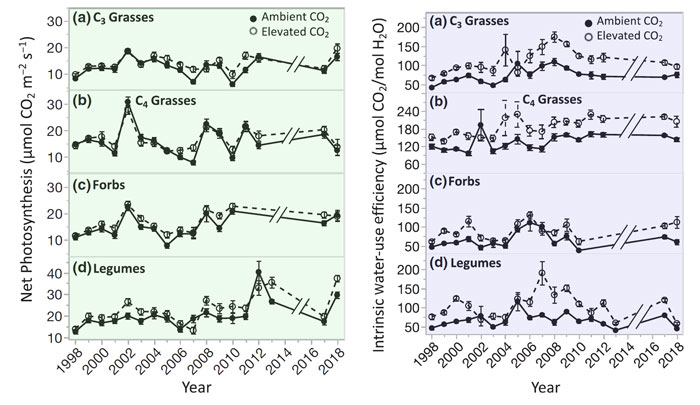| Tweet | Follow @co2science |
Paper Reviewed
Pastore, M.A., Lee, T.D., Hobbie, S.E. and Reich, P.B. 2019. Strong photosynthetic acclimation and enhanced water-use efficiency in grassland functional groups persist over 21 years of CO2 enrichment, independent of nitrogen supply. Global Change Biology 25: 3031-3044.
Long-term experiments conducted in the field are the gold standard for examining the response of plants to higher levels of atmospheric CO2. Unfortunately, very few studies have examined such impacts beyond one growing season, while even fewer studies have persisted for a decade or more.
One long-term experiment that has been in operation for over two decades now is located at the Cedar Creek Ecosystem Science Reserve in East Bethel, Minnesota, USA. There, in a free-air CO2 enrichment (FACE) environment, scientists have been investigating the interactive effects of CO2, nitrogen and biodiversity on various perennial grassland species. The CO2 enrichment at the site has been maintained at 180 ppm above ambient during daylight hours of the growing season and in a recent paper Pastore et al. (2019) provide an update on their findings after 21 years.
In terms of light-saturated rates of leaf net photosynthesis, the four scientists report that elevated CO2 stimulated this parameter by an average of 11.1% for three C3 perennial grass species, 5.7% for three C4 grasses, 11.6% for four C3 forbs and 14.8% for four C3 legumes (see the left panel of Figure 1). Interestingly, the authors note that "the positive CO2 effect [on photosynthesis] became greater over time" for each functional group of grassland species, including the C4 grasses, albeit the temporal trend observed was described as "modest." Furthermore, the authors report there was no interactive effect between elevated CO2 and nitrogen supply on photosynthesis.
Pastore et al. also observed a CO2-induced 23.3% decline in stomatal conductance across all species, which decline -- when coupled with the photosynthesis gains -- helped explain a near 50% average increase in intrinsic water use efficiency (iWUE) under elevated CO2. More specifically, as shown in the right panel of Figure 1, iWUE increased by 55% in C3 grasses, 38.6% in C4 grasses, 49.1% in C3 forbs and 61.1% in C3 legumes.
In discussing the significance of their findings, the scientists note that the positive responses of the C4 species, though small, shows that "C4 photosynthesis is not always CO2-saturated at ambient atmospheric CO2 concentration" and highlights "the need for better representation of C4 species in the CO2 enrichment literature." But perhaps the most significant observation was found in the increased iWUE of the grassland species, of which Pastore et al. say "could mitigate the impact of drought in the future by reducing plant water use in a variety of species and increasing soil moisture in some ecosystems."

Figure 1. Mean net photosynthesis (left panel) and intrinsic water?use efficiency (right panel) in (a) C3 grasses, (b) C4 grasses, (c) forbs, and (d) legumes grown at ambient (closed circles) or elevated (open circles) CO2 over 21 years. Data for each plant grouping are pooled across species and nitrogen treatments. Hash marks indicate a gap in years of data collection, not an axis break. Error bars represent standard error. Source: Pastore et al. (2019).




